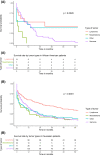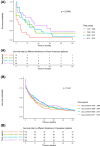Long-term outcomes of primary cardiac malignant tumors: Difference between African American and Caucasian population
- PMID: 34761875
- PMCID: PMC8683531
- DOI: 10.1002/cam4.4385
Long-term outcomes of primary cardiac malignant tumors: Difference between African American and Caucasian population
Abstract
Background: The survival outcome for primary cardiac malignant tumors (PMCTs) based on race has yet to be fully elucidated in previously published literature. This study aimed to address the general long-term outcome and survival rate differences in PMCTs among African Americans and Caucasian populations.
Methods: The 18 cancer registries database from the Surveillance, Epidemiology, and End Results (SEER) Program from 1975 to 2016 were utilized. Ninety-four African American (AA) and 647 Caucasian (CAU) patients from the SEER registry were available for survival analysis. The log-rank test was used to compare the difference in mortality between two populations and presented by the Kaplan-Meier curves. A multivariate Cox proportional hazards regression was used to determine the independent predictors of all-cause mortality.
Results: The overall 30-day, 1-year, and 5-year survival rates were 74%, 44.3%, and 16.6%, respectively, with a median survival of 10 months. There was no significant difference in survival rate between the two races (p-value = 0.55). The 1-year survival rate improved significantly during the study timeline in the AA population (13.3% during 1975-1998, 40.9% during 1999-2004, 50% during 2005-2010, and 59.7% during 2011-2016, p-value = 0.0064). Age of diagnosis, type of tumor, disease stage, and chemotherapy administration are the main factors that predict survival outcomes of PMCT patients. Interactive nomogram was developed based on significant predictors.
Conclusions: PMCTs have remained one of the most lethal diseases with poor survival outcome. Survival rate improved during the timeline in AA patients, but in general, racial differences in survival outcome were not observed.
Keywords: nomogram; primary malignant cardiac tumors; race; survival rate.
© 2021 The Authors. Cancer Medicine published by John Wiley & Sons Ltd.
Conflict of interest statement
The authors have no conflict of interest to declare.
Figures




References
-
- Simpson L, Kumar SK, Okuno SH, et al. Malignant primary cardiac tumors. Cancer. 2008;112(11):2440‐2446. - PubMed
MeSH terms
LinkOut - more resources
Full Text Sources

